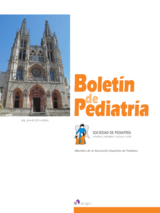Exoftalmos unilateral de corta evolución. Una forma de debut de un neuroblastoma
R. González Escudero , V. Gómez Dermit , R. López Almaraz
Bol. Pediatr. 2016; 56 (237): 186 - 190
El neuroblastoma (NB) es el tumor extracraneal sólido más frecuente en la infancia. Representa el 7% de los cánceres pediátricos. Se origina de la cresta neural, y puede apareceren cualquiera de los sitios anatómicos a lo largo de la cadena ganglionar simpática, así como en la glándula suprarrenal. El 90% ocurre en menores de 5 años. Presenta un amplio espectro de comportamiento clínico. Los estudios muestran metástasis orbitarias en el 10-20% de los casos. La proptosis y equimosis periorbitaria son consideradas dos de los signos clásicos del neuroblastoma en niños. Presentamos el caso de una paciente de 4 años de edad con un neuroblastoma metastásico que se manifestó como una proptosis de corta evolución al diagnóstico, sin otro tipo de sintomatología ni hallazgos en la exploración física. Tras las pruebas complementarias, se la diagnosticó de neuroblastoma estadio IV de la INSS (The International Neuroblastoma Staying System). No se localizó el tumor primario. Se realizó tratamiento con quimioterapia de inducción, terapia de acondicionamiento y trasplante autólogo de progenitores hematopoyéticos, entrando en remisión completa. Posteriormente inmunoterapia, manteniendo enfermedad residual negativa. Queremos destacar la importancia de un diagnóstico precoz en esta patología de cara a la supervivencia del paciente, y que siempre debe considerarse el diagnóstico de NB ante un exoftalmos en un paciente previamente sano. El tratamiento de los pacientes con neuroblastoma de altoriesgo es multimodal, habiendo mejorado el pronóstico el uso combinado de inmunoterapia, ácido 13 cis-retinoico y trasplante autólogo de médula ósea.
Unilateral exophthalmos with short evolution. One way to debut a neuroblastoma
Neuroblastoma (NB) is an extracranial solid brain tumor found most frequently during childhood. It represents 7% of the pediatric cancers. It originates in the neural crest and
can appear in any part of the anatomy along the ganglionic sympathetic chain, as well as in the adrenal gland. 90% of cases occur en children under the age of 5. It presents a broad spectrum of behavior. Studies have shown orbital metastases in 10-20% of cases. Proptosis and ecchymosis periorbitary are considered two classic signs of neuroblastoma in children.
We are presenting a case of a 4 year old female patient with metastatic neuroblastoma that manifested like a proptosis of short evolution to its diagnosis, without any other type
of symtomatololgy or findings in the physical exploration. After complementary tests she was diagnosed with stage IV neuroblastoma in the INSS (The International Neuroblastoma
Staying System). The primary tumor was not located. Complete remission was obtained using induction chemotherapy, conditioning therapy and autologous hematopoietic
progenitors transplant. After immunotherapy negative residual disease was maintained. We would like to highlight the importance of early diagnosis in this pathology facing the patient’s survival and must always consider the NB diagnosis when an exophthalmos
presents in a previously healthy patient. Treatment in patients with high risk neuroblastoma is multimodal, having improved the prognosis by using a combination of immunotherapy, 13-cis-retinoic acid and the autologous bone marrow transplant.
Artículo completo (PDF) (109 kb.)
- Oncología
Buscar en el boletín
Año 2016, Volumen 56, Número 237

Boletín completo en PDF (655 kb.)